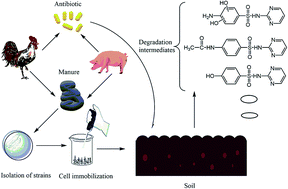Investigating the biodegradation of sulfadiazine in soil using Enterobacter cloacae T2 immobilized on bagasse†
Abstract
The application of the wide-spectrum antibiotic sulfadiazine (SD) in veterinary medicine has created serious environmental issues due to its high mobility and non-degradability. This research details the investigation of SD biodegradation in soil, as well as the degradation pathways of SD by immobilized SD-degrading bacterial strains on a biomass carrier. Soil remediation is generally expected to be more difficult compared with in an aqueous and air environment because of the stealth and diversity of pollutants and the complexity of soil matrices (soil texture, pH and organic matter). In this study, an immobilization system consisting of bagasse and a microorganism is proven to have a high degradation potential, and is non-toxic, low-cost, renewable and applicable for SD biodegradation in soil. Single colonies were obtained by repeatedly streaking cultures supplemented with increment (50 mg L−1) of SD concentration. According to biochemical tests, 16S rDNA gene sequence homology and internal transcribed spacer (ITS) sequence analysis, they are identified as T2 (Enterobacter cloacae) and Z3 (fungal entophyte), respectively. Batch tests were conducted to establish a link between the SD degradation rate and environmental conditions, such as the temperature, pH and heavy metal ions. Under optimum conditions (28 °C, pH = 3.5, 15% inoculation amounts of T2), the degradation of SD in soil reached 78.19%. The degradation pathway of SD is summarized on the basis of the ultra-high performance liquid chromatography-quadrupole time-of-flight (UPLC-Q-TOF) analyses of the biodegradation products.



 Please wait while we load your content...
Please wait while we load your content...